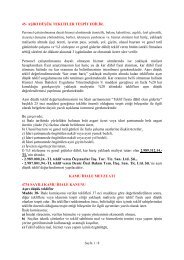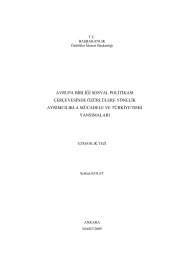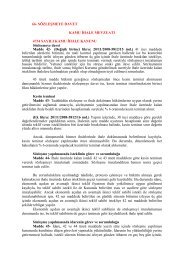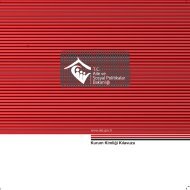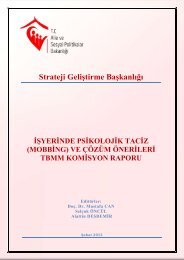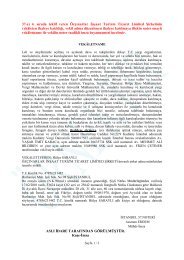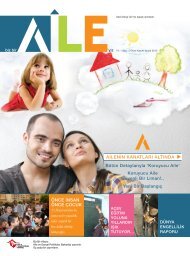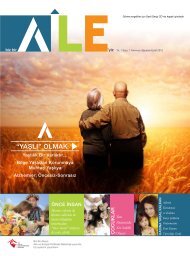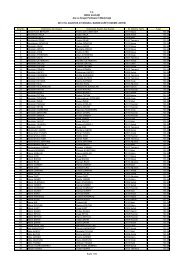Sosyal PolÄ°tÄ°ka tÄ°ka - EÄitim ve Yayın Dairesi BaÅkanlıÄı - Aile ve ...
Sosyal PolÄ°tÄ°ka tÄ°ka - EÄitim ve Yayın Dairesi BaÅkanlıÄı - Aile ve ...
Sosyal PolÄ°tÄ°ka tÄ°ka - EÄitim ve Yayın Dairesi BaÅkanlıÄı - Aile ve ...
- No tags were found...
Create successful ePaper yourself
Turn your PDF publications into a flip-book with our unique Google optimized e-Paper software.
Yıl: 12 Cilt: 7 Sayı: 29 Temmuz - Aralık 2012<br />
3.2. The CCT Programme in Turkey<br />
The CCT programme in Turkey was firstly launched by the Social Risk Mitigation Project<br />
(SRMP) in 2003. The SRMP was a part of responses by the Go<strong>ve</strong>rnment of the day<br />
to devastating earthquakes and se<strong>ve</strong>re financial shocks that struck Turkey at the end<br />
of 1990s and beginning of 2000s. The SRMP was designed to ser<strong>ve</strong> for two essential<br />
goals as contributing to mitigate the destructi<strong>ve</strong> impact of these natural disasters and<br />
financial crisis o<strong>ve</strong>r poor families and fostering their capacity to o<strong>ve</strong>rcome similar<br />
possible crisis (The World Bank, 2008, p.7). The project was financed mainly by Work<br />
Bank through loan agreement. Howe<strong>ve</strong>r, Go<strong>ve</strong>rnment of Turkey made a significant<br />
financial contribution for the SRMP. SRMP activities were coordinated by a Project<br />
Coordination Unit (PCU), embedded to the Prime Ministry General Directorate of Social<br />
Assistance and Solidarity (GDSAS), which is predecessor of GDSA. Following the<br />
closing of the SRMP in March 2007, the programmes, including the CCT programme,<br />
that were carried out by SRMP PCU were operationally and financially undertaken by<br />
GDSA. From the beginning of SRMP, there were and are two types of benefits under<br />
the CCT programme in Turkey as education and health benefit. Similar to other CCT<br />
programmes, applicants are assessed by mean tests and they are required to perform<br />
certain conditions in order to maintain their status once they are granted beneficiary<br />
status. These conditions which are vital for the maintenance of beneficiary status will<br />
be respecti<strong>ve</strong>ly detailed for each type of benefits.<br />
In order to benefit from CCT education or health component, applications should<br />
be made to local Social Assistance and Solidarity Foundations (SASFs) located in each<br />
province and sub-province. Applicants are usually mothers and expectant mothers or<br />
legal carers of children in exceptional conditions. GDSA benefits from a proxy means<br />
scoring formula to examine applicants. This formula was generated by a model that<br />
aims to estimate “per capita household consumption expenditure” as a function of<br />
household assets, demographics, geographic location, and other relevant variables.<br />
Relevant data of applicants regarding these variables are collected through an application<br />
form at the beginning of application. Then, the data on this application form<br />
is <strong>ve</strong>rified by using Social Assistance Information System (SOYBIS), run by GDSA and<br />
random house visits. After data <strong>ve</strong>rification phase, children of applicant or expectant<br />
mother are granted beneficiary status if the result of scoring formula is below the<br />
predetermined cut-off score. The eligibility of the beneficiary status is checked once<br />
in a year (International Food Policy Research Institute, 2007, p.79).<br />
CCT education and health benefits ha<strong>ve</strong> specific target groups, conditions and they<br />
also co<strong>ve</strong>r different age groups. For instance, CCT education benefits target the children<br />
of the families who are among the poorest six percent of the population. After<br />
being granted CTT education beneficiaries as result of similar process abo<strong>ve</strong>, children<br />
are required to ha<strong>ve</strong> eighty percent of school attendance rate and not to repeat the<br />
56



